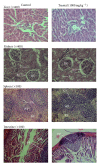Microbiological and Pharmacological Evaluation of the Micropropagated Rubus liebmannii Medicinal Plant
- PMID: 22966243
- PMCID: PMC3433153
- DOI: 10.1155/2012/503031
Microbiological and Pharmacological Evaluation of the Micropropagated Rubus liebmannii Medicinal Plant
Abstract
Rubus liebmannii is an endemic species from Mexico used in traditional medicine primarily to treat dysentery and cough. The in vitro activity against Giardia lamblia and Entamoeba histolytica that produces the ethanolic extract of the aerial parts of the plant led us to expand the pharmacological and phytochemical research of this species. Gastrointestinal disorders including amebiasis remain one of the health problems that need to be addressed and it is of interest to find alternatives that improve their treatment. Also, it is important to emphasize that R. liebmannii grows wild in the country and is not found in abundance; therefore, alternatives that avoid overexploitation of the natural resource are mandatory. Ongoing with the evaluation of the potentialities that R. liebmannii possesses for treating infectious gastrointestinal diseases, the aim of the present study was to evaluate the biological effects and the chemical composition of the micropropagated plant.
Figures

References
-
- Rzedowski J, Rzedowski G. Flora Fanerogámica del Valle de México. 1st ed edition. México City, Mexico: Editorial Continental; 1981.
-
- IBUNAM:MEXU:PVsn45838, http://unibio.unam.mx/collections/specimens/urn/IBUNAM:MEXU:PVsn45839.
-
- Aguilar-Contreras A, Camacho-Pulido JR, Chino-Vargas S, Jácquez-Ríos P, López-Villafranco MA. Plantas Medicinales del Herbario del IMSS: Su Distribución por Enfermedades. 1st ed edition. México City, Mexico: Editorial IMSS-Roche Syntex; 1994.
-
- Romero VS. Actividad Antiprotozoaria de los Productos Derivados de las Partes Aéreas de Rubus Liebmannii Focke. México City, Mexico: Tesis de Licenciatura. Facultad de Química, UNAM; 2008.
-
- Meckes M, Villarreal ML, Tortoriello J, Berlin B, Berlin EA. A microbiological evaluation of medicinal plants used by the Maya people of southern Mexico. Phytotherapy Research. 1995;9(4):244–250.
LinkOut - more resources
Full Text Sources

